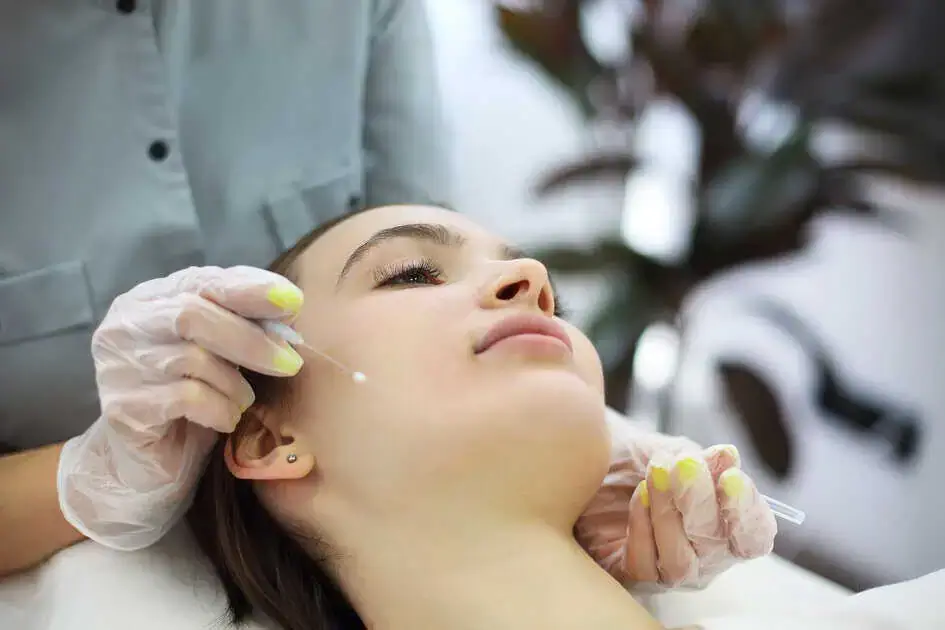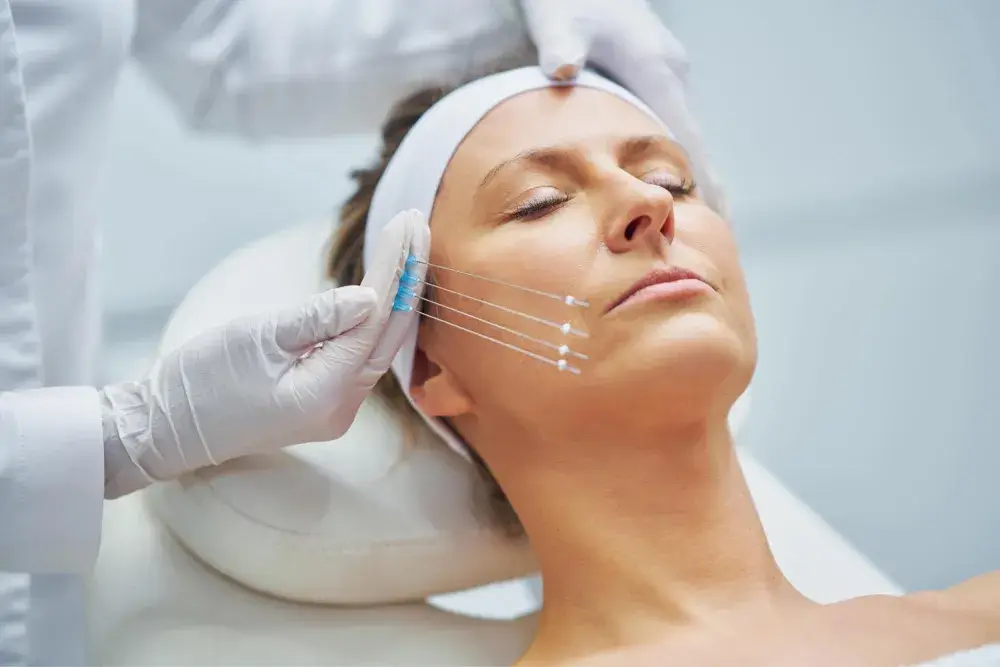
About Intraline PDO Threads – Excellent Safety Profile and Virtually Non-Allergenic
Intraline
2025-07-24
Discover why Intraline PDO threads are favored in aesthetic medicine for their excellent safety profile, minimal allergenic risk, and effectiveness in non-surgical skin lifting and rejuvenation.
Joanna Carr
In the world of minimally invasive facial treatments, PDO thread lifting has gained popularity due to its ability to lift and tighten the skin with minimal downtime. A recent meta-analysis of over 2,800 patients found that complication rates are very low, with infections occurring in just 2% of cases. Most side effects resolve on their own without the need for further intervention.
Intraline PDO threads represent the next generation of PDO thread technology. These threads are designed with exceptional biocompatibility and virtually no risk of allergic reactions, making them a safe option for a wide range of patients. Intraline minimizes irritation while enhancing collagen production by refining the polymer backbone and optimizing the thread geometry.
In this article, we’ll explore Intraline PDO threads in depth. We will discuss their safety, how they work, the expected clinical outcomes, and why they may offer distinct advantages over traditional PDO threads.
Key Takeaways
- Intraline PDO threads are made from polydioxanone (PDO), a biodegradable, non-animal-derived material that offers excellent biocompatibility and low immunogenicity.
- It is suitable for patients with sensitive skin or previous post-procedural reactions.
- Intraline offers a range of thread types, including Mono, Spiral/Screw, Triple, and Cog. These are designed for different aesthetic goals, including skin tightening, volume restoration, and facial lifting.
- The Triple threads offer stronger support and are ideal for areas needing greater lift, such as the jawline and neck, while Mono threads are perfect for subtle rejuvenation of fine lines and early signs of aging.
- Intraline PDO threads stimulate collagen production and promote long-term skin rejuvenation by inducing biostimulation as the threads dissolve, leading to firmer, smoother skin even after the procedure.
- Intraline threads provide a safe and low-downtime treatment with mild and temporary side effects, such as bruising or swelling, which typically resolve within 48–72 hours.
- The PDO threads from Intraline are an affordable and effective solution for non-surgical facial rejuvenation, making them a valuable option for those seeking high-quality aesthetic treatments with minimal risk and excellent results.
About: Doctor Medica is your trusted supplier of top-quality dermal fillers, viscosupplements, and more for your medical practice. We offer genuine products from leading brands at the lowest prices in the market. If you’re looking to order Intraline Dermal Fillers or PDO Threads online for your practice, contact Doctor Medica today.
What Makes Intraline PDO Threads Different From Other Brands

Intraline PDO threads are crafted from pure polydioxanone (PDO), a fully absorbable and biocompatible material widely used in surgical sutures. Unlike other PDO thread brands that may incorporate synthetic or animal-derived substances, Intraline prioritizes safety by minimizing the risk of allergenic reactions. This approach makes them an ideal option for a broader range of patients, including those with sensitive skin or a history of post-procedural reactions.
By refining the polymer backbone and optimizing thread geometry, Intraline minimizes tissue irritation while maximizing collagen induction. The absence of animal-derived additives and the use of medical-grade materials further reduce the immunogenic risk, making Intraline PDO threads particularly suitable for patients with sensitive skin or those who have experienced adverse reactions with other injectable treatments.
These threads come in various designs, each targeting different aesthetic needs. Here’s a closer look at the range of Intraline PDO threads:
- Mono Threads: Ideal for skin tightening and subtle rejuvenation.
- Spiral/Screw Threads: Provide volume and stimulate deeper collagen production.
- Cog Threads: Feature barbed edges for mechanical lifting in areas like the jowls or neck.
- Triple Threads: A stronger variation of Twin/Braided threads, these are designed for deeper support and enhanced lifting in broader areas.
By offering these different options, Intraline provides a flexible and customizable solution to address a variety of aesthetic concerns.
Types of Intraline Threads: Mono, Screw, Twin, and Cog

When planning a PDO thread treatment, choosing the right thread is key to achieving the desired results. Intraline offers a comprehensive range of thread types, each designed to address specific aesthetic concerns—from fine lines and skin tightening to facial lifting and volume restoration. Here’s a breakdown of Intraline’s thread options:
Mono Threads
- Smooth, single-strand threads that are inserted in a mesh-like pattern.
- Stimulate collagen production and mildly tighten the skin.
- Ideal for subtle rejuvenation, particularly for early signs of aging in the cheeks, forehead, and under the eyes.
Spiral/Screw Threads
- These threads are designed in a helical or coiled form to provide additional surface area.
- Create a volumizing effect due to their spring-like tension.
- Great for restoring mid-face volume and correcting nasolabial folds while also promoting robust tissue stimulation and collagen production.
Triple Threads
- Composed of three intertwined strands, these threads provide a stronger structure than the Twin/Braided variety.
- Offer enhanced structural support, making them perfect for larger areas that require lift and tightening, such as the jawline or neck.
- The Triple threads are designed to provide greater durability and resistance to dynamic facial movement.
Cog Threads (360° Barbed)
- Unidirectional or multidirectional barbs anchor into the tissue, creating an immediate lifting effect.
- Ideal for treating sagging jowls, jawline contouring, and neck lifting.
- These threads require expert placement to ensure symmetry and optimal tension, delivering visible and lasting results.
Clinical Uses of Intraline Threads in Facial and Body Lifting
Intraline PDO threads are gaining popularity for both facial and body contouring due to their dual-action design, which provides both immediate lifting and long-term skin rejuvenation. Clinicians can combine these threads with Intraline dermal fillers to create a balanced and natural-looking result.
Here’s a look at Intraline PDO threads‘ use for both facial and body enhancements:
- Immediate Mechanical Lift: Barbed threads grip tissue upon insertion, providing an instant lift to sagging skin and offering visible improvement in areas such as the cheeks, jawline, and jowls immediately after the procedure.
- Biostimulation: As the PDO threads dissolve over time, they stimulate the production of collagen, elastin, and hyaluronic acid over the next 4 to 6 weeks. This ongoing process improves firmness, elasticity, and hydration, continuing to enhance the skin even after the body absorbs the threads.
- Facial Indications: Intraline threads can lift the lower face, enhance the jawline, soften marionette lines, and elevate sagging brows. They can also be target the area under the chin and around the neck to restore youthful definition.
- Body Applications: These threads can also target areas like the upper arms, abdomen, thighs, and décolletage to improve mild skin laxity. Patients often see firmer, smoother skin in these areas where traditional fillers might not be as effective.
By addressing both sagging and skin texture, Intraline threads provide a comprehensive rejuvenation approach. When used in conjunction with Intraline dermal fillers, practitioners can achieve a structural lift and volume restoration, resulting in truly customized aesthetic outcomes.
Safety, Biocompatibility, and Practitioner Confidence with Intraline PDO
Intraline PDO threads are made from polydioxanone, a biodegradable material used for many years in surgical sutures. This ensures excellent safety and tissue compatibility. Since the threads are synthetic and non-animal derived, they help reduce the risk of allergenic reactions and inflammation. The fully absorbable nature of PDO means the body will gradually break down the threads over several months, leaving no permanent residue and triggering no adverse immune responses.
Common Side Effects
- Temporary bruising, swelling, and redness at the site of insertion are the most common effects, and these usually resolve within 48–72 hours.
- Proper technique and post-procedure care (such as avoiding intense facial movements and alcohol) can help reduce these risks.
Intraline PDO threads are designed for easy handling and precise placement, allowing for effective lifting and collagen stimulation with minimal risk of complications. Healthcare providers benefit from ergonomically designed needle and cannula systems, which ensure comfort during treatment and accuracy in results.
Conclusion
Intraline PDO threads offer a versatile, safe, and effective solution for both facial and body rejuvenation. With a variety of thread types to suit different aesthetic needs, Intraline provides customized treatment options for skin tightening, lifting, and volume restoration. The biocompatibility and low complication rates make Intraline a valuable addition to modern aesthetic practices, offering patients natural-looking results with minimal downtime.
Whether enhancing facial contours, restoring volume, or tightening skin, Intraline PDO threads remain a popular choice for achieving lasting, high-quality results. With proper management and patient monitoring, Intraline threads continue to offer a trusted, safe, and cost-effective solution for those seeking non-surgical rejuvenation.
FAQs
1. How long do Intraline PDO thread results last?
Typically 12–18 months, varying by thread type, placement, and individual collagen response.
2. Are Intraline PDO threads safe for sensitive skin?
Yes, using biocompatible PDO avoids immunogenic risks, making it well-tolerated among sensitive patients.
3. Can I combine threads with fillers?
Absolutely. Many clinicians pair threads with dermal fillers for enhanced contouring and volume restoration.
4. How soon can patients resume normal activities?
Most patients resume daily activities within 24–48 hours. Avoid strenuous exercise, heat, and facial massages for at least a week.
References
Zhou X, Zhuang S. A meta-analysis of complications of thread lifting. medRxiv (Cold Spring Harbor Laboratory). Published online March 11, 2025. doi:10.1101/2025.03.10.25323087
Surowiak P. Barbed PDO Thread Face Lift: A Case Study of Bacterial Complication. Plast Reconstr Surg Glob Open. 2022;10(3):e4157. Published 2022 Mar 7. doi:10.1097/GOX.0000000000004157
Li YL, Li ZH, Chen XY, Xing WS, Hu JT. Facial thread lifting complications in China: analysis and treatment. Plastic & Reconstructive Surgery Global Open. 2021;9(9):e3820. doi:10.1097/gox.0000000000003820
Related Articles
Joanna Carr
Unveiling The Wonders Of Pdo Threads: What Are They, And How Do They Work?
Interested to learn more about Unveiling The Wonders Of Pdo Threads? Browse Doctor Medica's comprehensive listing of blog posts.
Joanna Carr
Lanluma Hip Dips – Is It a Viable Treatment?
Can Lanluma effectively treat hip dips? Discover how this collagen-stimulating filler enhances contours and whether it’s the right solution for subtle...
Joanna Carr
Synvisc vs Monovisc – A Thorough Comparison
Osteoarthritis is a common joint disorder affecting millions worldwide, leading to activity limitations and significant economic burdens.


